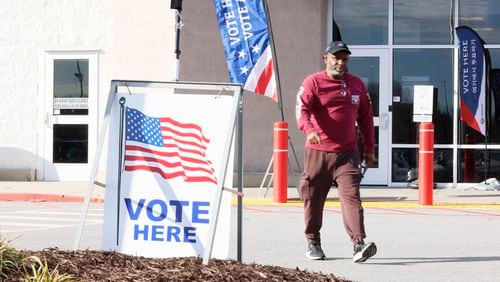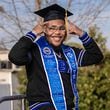Published Jan. 9, 2011
It wasn’t Charlayne Hunter’s intention to be brave. She didn’t set out to break the color barrier at the University of Georgia.
But, even as an 18-year-old freshman, she knew she was smart and focused. She just wanted to be a reporter and thought UGA’s journalism program offered her the best path to get there.
Ultimately, she would end up becoming a well-known journalist who would move into the roles of news anchor and chronicler of world events. But before she ever covered the news, Hunter was the news.
Fifty years ago today, an impeccably dressed teenager with steely hazel eyes walked past the Arch and took the first steps toward fulfilling her dream of becoming a real-life Brenda Starr. She and a high school mate, Hamilton Holmes, registered for class, becoming the first black students to do so.
To Hunter, who later became Charlayne Hunter-Gault, it just seemed logical that she enroll at UGA, which had a top-notch journalism program.
The admittance of the two, followed by a gaggle of reporters, came amid the requisite court battles, protests, angry stares and a nighttime student riot.
This week, Hunter-Gault returns to Athens to give speeches and take part in round-table discussions on racial issues that she hopes will turn into a year-long series of television and radio programs and ultimately even a college course.
“We need to have an honest discussion on race,” she said. “It’s hard to find a reasonable discussion; the decibel level has been raised. I want to drill down the conversation over a year’s time, not just a 24-hour discussion.”
The news specials — she is working to get them broadcast on National Public Radio and PBS — would be tied to news events that lend themselves to further public discussion on race.
The media veteran worries that the intolerance and anger she increasingly sees dominating today’s news programming and talk radio is bringing forth the same kind of messages that drew a mob of students to her dormitory shortly after she came to campus. Her windows were shattered by bricks, and she and Holmes were temporarily suspended by the school for “safety reasons.”
The next day, editors in the Red and Black, the student newspaper, criticized “rabble rousers” and “curious onlookers” for fomenting anger toward Hunter-Gault.
The rabble rousers are back, she said and their aim isn’t toward intelligent discussion.
“Today, I think it’s preferable to get people aroused and make them want to go out and fight,” she said during a short stop in Atlanta last week. “Now it just sows dissension, not knowledge. It’s too toxic. It’s to divide people.”
She preferred not to call out the modern-day fomenters. “I’m a journalist, so I have to be careful of how I put it when criticizing my own profession,” she said. “I’m just saying let’s have these arguments intelligently and constructively.”
Hunter-Gault, 68, went on to a distinguished career after leaving UGA, writing at the New Yorker and The New York Times, spending 20 years on the MacNeil/Lehrer NewsHour, then moving to South Africa in 1997 with her husband Ronald Gault, an investment banker. There, she covered the continent for NPR and CNN and now divides her time between homes in Martha’s Vineyard and South Africa.
She came to Atlanta last week for a short round of interviews before having to hurry off to a plane to attend a family funeral in Chicago. Hunter-Gault has always had an almost regal bearing on television, coupled with an easy smile. It was that same smile that was often caught on camera during those tense days 50 years ago.
In a round of interviews last week at the Georgia Public Broadcasting studios, she flashed a toothy grin and apologized for just rolling out of bed. While putting on headphones for a radio interview, a deep-sounding disembodied voice came over the system. “Hello, Charlayne, Do you know who this is?”
No, she said with a curious look. It was Vernon Jordan, the well-known civil rights lawyer, presidential adviser and investment banker who, in 1961, was a newly minted lawyer helping the two students wage their case. Jordan was part of a small entourage who accompanied Hunter-Gault and Holmes, who died in 1995, to campus.
“These two people were taking on the entire state of Georgia; they were not wanted,” Jordan said as the interview progressed. “You have to remember what the state of Georgia was in 1961. For black people, it was a mean place.”
It was Jordan, she said, who discovered key evidence that helped win her admission. The university claimed it had no room in the dorms to accommodate her, but Jordan found that a white girl with almost the same circumstances was allowed to transfer in.
Hunter-Gault’s remembrances come with dispassionate observation. On her second night on campus, more than 1,000 angry protestors gathered outside her dorm. She heard a window break, then another. “I looked and my suitcase was full of glass,” she said. “I thought, ‘Oh, this is what it’s like to be in the middle of a riot.’”
From the start, the fledgling journalism student got an immersion in her chosen craft.
“It was a good news story, and there were all these journalists covering it,” she said. “I could see early on the elements you needed to be a good journalist. Some were, ‘Just the facts, ma’am.’ Others were fomenting rioting.”
An “Extra” edition of the Red and Black of Jan. 9, 1961 has a sub-headline noting “Top Newsmen Cover Arrival.” That story was written by a Tommy Johnson, who later headed CNN.
Hunter-Gault watched close-up the daily workings of some journalistic standouts like Claude Sitton, then the Southern correspondent for The New York Times, and Calvin Trillin, the author who was then a young reporter at Time.
In fact, Trillin two years later published his first book — “An Education in Georgia: Charlayne Hunter, Hamilton Holmes, and the Integration of the University of Georgia.”
Trillin described how civil rights leaders made sure the first two students chosen for the important task were squeaky clean. “Both had always been considered perfectly cast for the role. Good looking and well dressed, they seemed to be light-complexioned Negro versions of ideal college students, models for an autumn Coca-Cola ad in a Negro magazine.”
Their successful enrollment, Trillin wrote, “was the turning point for Georgia and was accomplished in a way and at a time that made it inevitable that the state would move forward than backward.”
“I learned from Trillin that we can be human and still do our jobs well,” Hunter-Gault said. “We can be fair and balanced. But you don’t have to be an inanimate object.”
A humanistic approach has helped, she said, especially when covering touchy social issues or talking to the poor.
Not long ago, she approached the mother of a 3-year-old killed by police in South Africa. She brought the grieving woman a small piece of art piece with an uplifting message and told her she was not only a journalist, she was a mother.
Her move to South Africa coincided with the black majority taking the reins of government. She covered the transition, a time when President Nelson Mandela, the Apartheid foe who spent 27 years in prison, pushed a policy of reconciliation, urging citizens to forgive the transgressions of the past so society could move on.
Ten years ago, Hunter-Gault returned to campus to celebrate the 40th anniversary of the school’s desegregation, and the university announced that the academic building where she and Holmes registered would be named after the two racial pioneers.
During the commemoration ceremonies, Ernest Vandiver, who was governor in 1961, apologized for his “intemperate remarks” at the time.
“It was a great moment. I was living in South Africa with Mandela and a spirit of reconciliation,” she said. “It was great to hear someone who led the opposition to us say that he was wrong. That was hopeful.”






